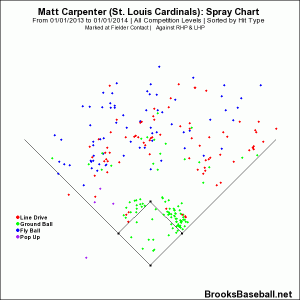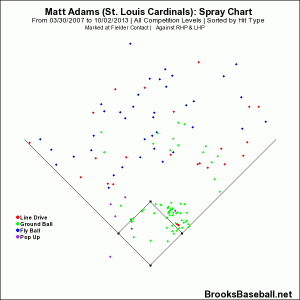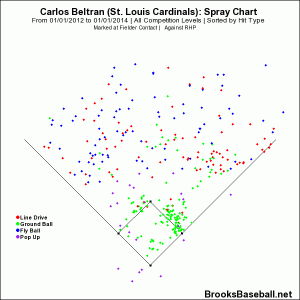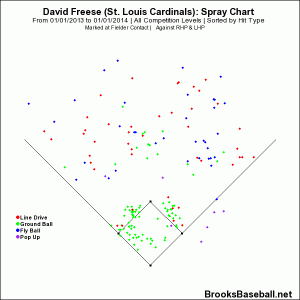The ascension of the Pittsburgh Pirates, from two decades of losing to 94 wins and the NL Wild Card, was not an easy one. The franchise had to completely revamp everything; from they way they do business on the international market to the way they play on the field. Gone were the frugal Pirates of the past. In 2011, GM Neil Huntington and his mates scoured the high seas, spending a record $17 million in the amateur draft in order to turn the franchise around. And while many of those players (top pick Gerrit Cole aside) have yet to make an impact on the big league level, the message was sent. Pittsburgh was here to compete.
That aggressive front office approach in the draft has bled over into other areas of the franchise as well. After decades of doing everything in their power to avoid spending money on free agents, Pittsburgh opened up the coffers for Russell Martin, who was brought in on a 2-year/$17 million dollar deal to fortify what had previously been an extremely weak catching position. Along with Martin, veterans AJ Burnett, Wandy Rodriguez, and Justin Morneau among others have been traded for in an effort to raise the roster’s overall talent level. And perhaps most importantly, modern-day analytical analysis has been embraced.
Nowhere is that new, modern approach to baseball more evident than in the Pirates’ commitment to the defensive shift. Pittsburgh was one of the shiftiest teams in baseball this season, using one defensive maneuver or another over 400 times. That ranks 2nd among all of the franchises currently in the playoffs, trailing only the original super-shifters, the Tampa Bay Rays. That’s a huge jump from 2012, when Pittsburgh shifted just 105 times and the numbers back up just how effective all those extra defensive movements were. Pittsburgh ranked 3rd in baseball as a team in defensive runs saved and they finished tied for 7th in the league in defensive efficiency, which is the percentage of balls put in play that are then converted into outs.
The effect of those extra shifts is magnified to even greater levels once you take Pittsburgh’s ground ball heavy pitching staff into consideration. The Pirates generated grounders more frequently than any other staff in baseball, getting hitters to roll over 52.5% of the time. That’s the highest percentage of swift choppers, slow rollers, and scalding bouncers that baseball has seen in over a decade and that makes the placement the fielders on the diamond extremely important.
So how will Clint Hurdle and the Pirates set up the board against a potent and dangerous St. Louis Cardinal lineup? Here are a few educated guesses:
The Obvious Candidates
The Pirates should feel very comfortable shifting against the Cardinals’ lead-off man because he rarely, and I mean rarely, ever hits the ball where the 3rd baseman normally plays.
 In over 600 at-bats this year, Carpenter pushed somewhere between 20-25 balls to the left side of the infield, which should allow Pittsburgh to make use of some sort of shift. They attempted a couple of different defensive formations during the regular season, the most prominent of which was shading 2nd baseman Neil Walker heavily toward the 1st base bag, but none of it seemed to effect the Cardinals’ offensive catalyst too much. He still managed to hit .278 with 6 doubles, 2 triples, and a homer over the course of 18 head-to-head match-ups.
In over 600 at-bats this year, Carpenter pushed somewhere between 20-25 balls to the left side of the infield, which should allow Pittsburgh to make use of some sort of shift. They attempted a couple of different defensive formations during the regular season, the most prominent of which was shading 2nd baseman Neil Walker heavily toward the 1st base bag, but none of it seemed to effect the Cardinals’ offensive catalyst too much. He still managed to hit .278 with 6 doubles, 2 triples, and a homer over the course of 18 head-to-head match-ups.
The best pinch-hitting option for the Cardinals is, without a doubt, lefty Matt Adams. The giant slugger provides big pop off the bench, hitting 31 extra-base hits in around 300 at-bats this year. The only downside is that he’s a heavy pull hitter, to the point that Clint Hurdle should feel completely comfortable putting on the overshift. In fact, the NL’s future manager of the year has been so comfortable shifting on Adams that he’s been completely willing to roll the dice, using 2nd baseman Neil Walker as a short right fielder even with runners on base in a tight game. And after seeing how effective the shift was in completely neutralizing the big man’s bat during the regular season — Adams hit just .133 with no extra-base hits in 30 at bats against Pittsburgh– why wouldn’t Hurdle continue to roll the dice?
This one comes with a caveat: only shift Beltran when he’s facing a right-hander. The 36-year-old veteran still exhibits solid pull tendencies when he’s facing a southpaw, but those same tendencies are exaggerated to the extreme when he’s hitting left-handed.
Since becoming a Cardinal in 2012, Beltran has rarely shown a balanced approach from the left side, choosing instead to focus on pulling the ball with authority. That approach has paid off handsomely, leading to 2 All-Star appearances and 56 homers, but it leaves the outfielder susceptible to the shift. Expect Pittsburgh to continue using a lighter version of the Ted Williams shift when Beltran is at the plate against a right-handed pitcher.
The Not-So-Obvious But Advisable One
The Cardinals’ 2011 postseason hero was absolutely manhandled by the Pittsburgh rotation during the regular season, hitting just .154 with 12 strikeouts. A big part of Freese’s problem against the Pirates this year was his inability to elevate any of the pitches Pittsburgh was dealing out. He put the ball in play exactly 40 times against Pittsburgh and 26 of those appearances led to an out without the ball leaving the infield. And with only 2 of those 26 balls going to the 1st baseman, you can expect the Pirates to shade the right-handed hitting Freese to pull, just like they did for most of 2013.
Pittsburgh’s staff will also have to find a way to negotiate around a few other extremely talented hitters, including Allen Craig, Matt Holliday, and Yadier Molina. All three of these All-Stars approach each at bat looking to take the ball into the right-center field gap with authority, which makes them both extremely dangerous. Holliday tormented the Bucs by hitting .342 with 15 RBI this year and although the Pirates kept Molina in check, you never know when he might bust out. I’m guessing that the Pirates will continue to shade all three of these All-Stars, depending on game situation of course. Craig and Holliday have solid, but not great, pull tendencies, especially when they hit ground balls, so expect shortstop Clint Barmes to shade toward 3rd while Neil Walker cheats toward the middle of the diamond.
———————
Pittsburgh’s absolute best shot at emerging victorious in the NLDS is going to be through run prevention. The Buccos finished 9th in the NL in runs scored all year, averaging nearly a run less per game than the Cardinals. They lost every single time they allowed the Cardinals to score more than 4 runs this year and while almost every team loses more often than not if they give up 5 runs, it’s practically a guarantee for the offensively challenged Pirates. They won just 9 games this season when surrendering 5 or more runs, which makes Hurdle’s little defensive machinations all the more important.
Big thanks to Baseball-Reference, Fangraphs, and Brooks Baseball for the statistical help!



